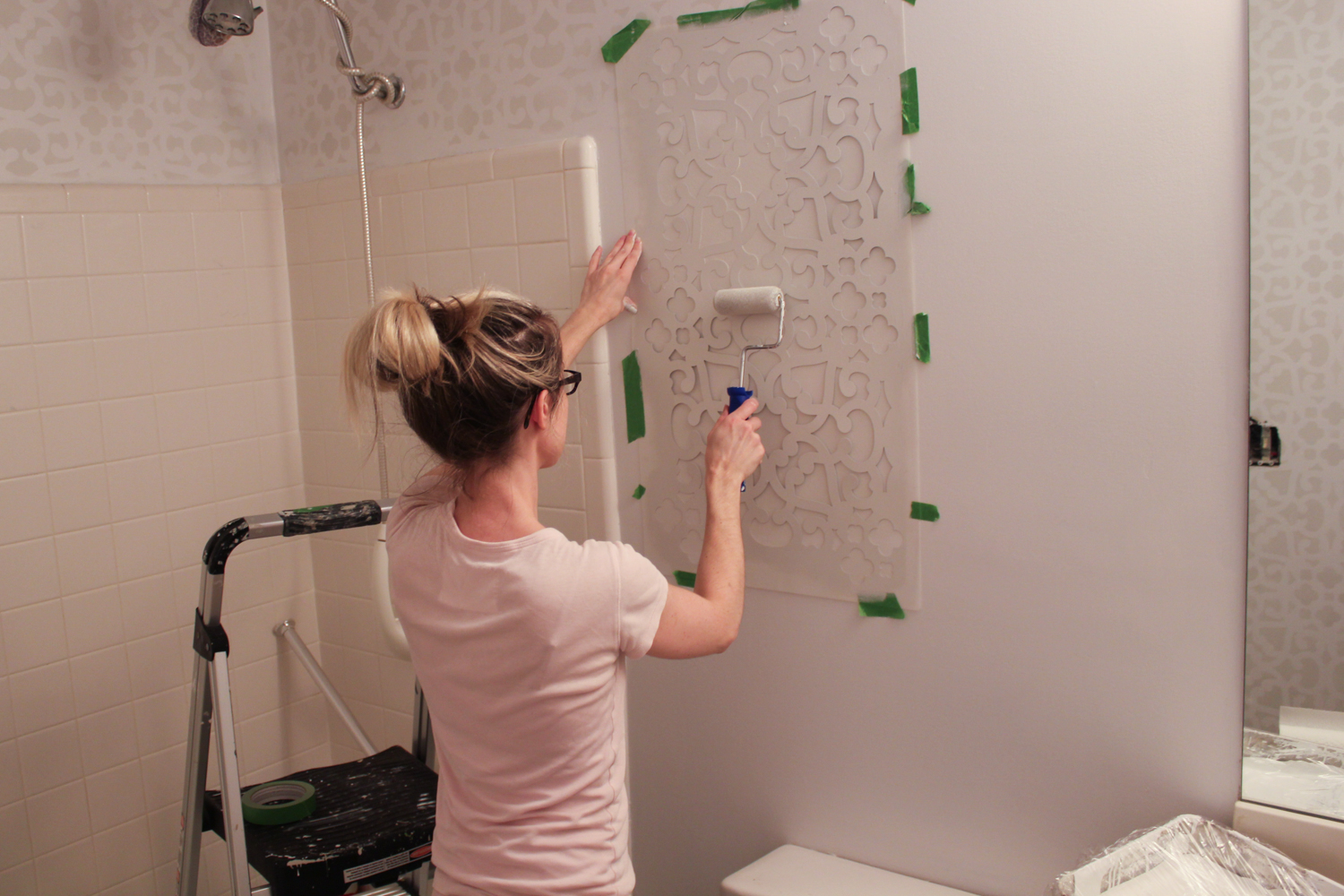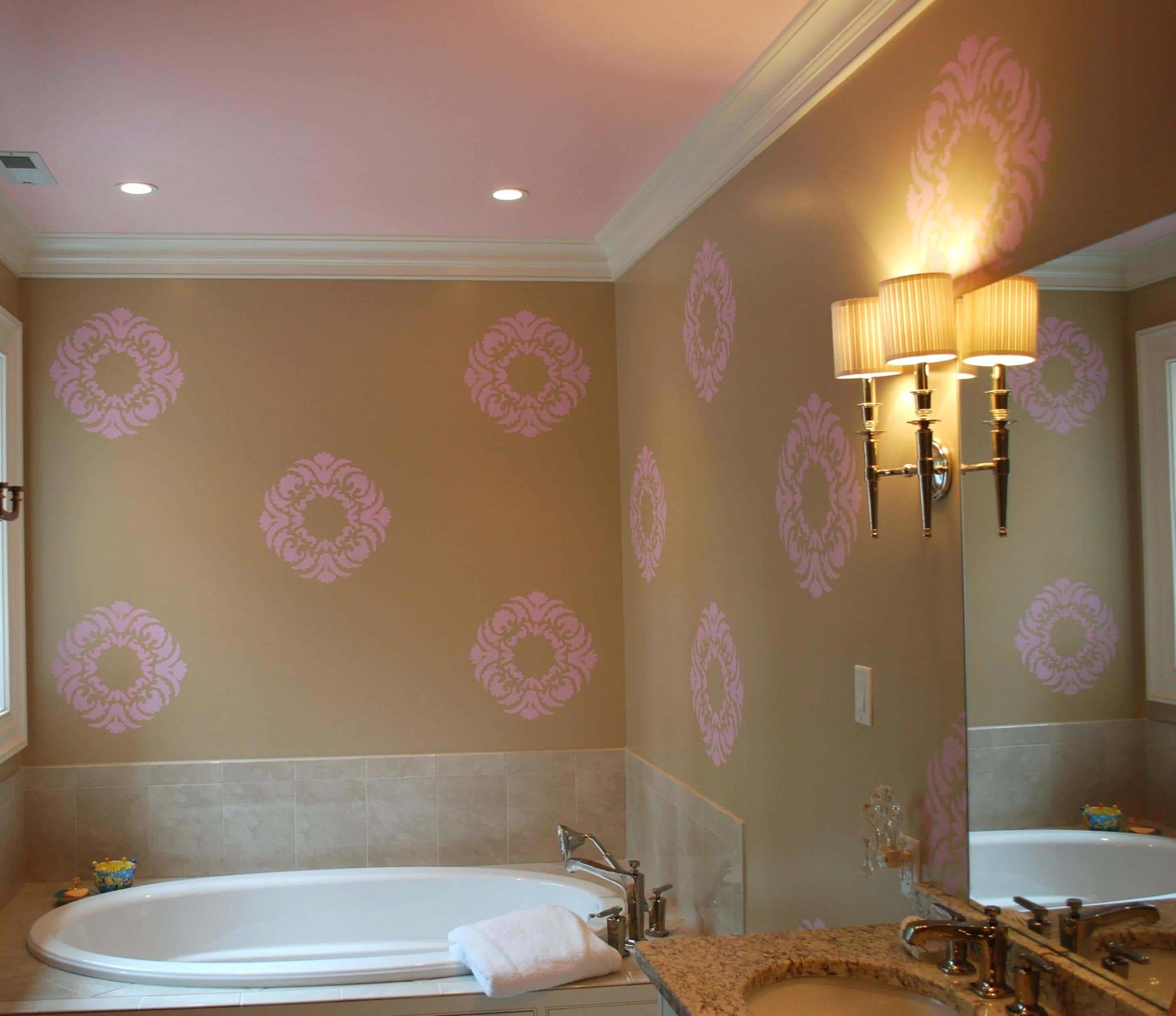Choosing the Right Stencil Size and Design

Stencil size and design are crucial considerations when transforming your bathroom with artistic flair. The right stencil size can create a dramatic impact, while a well-chosen design can complement your existing decor and enhance the overall aesthetic.
Determining the Appropriate Stencil Size
The stencil size you choose should be proportionate to the size of the wall or surface you intend to decorate. A large stencil can overwhelm a small bathroom, while a small stencil may get lost on a large wall. Here are some tips to help you determine the appropriate size:
- Consider the dimensions of your bathroom: Measure the wall space where you plan to apply the stencil. A general rule of thumb is to choose a stencil that is about one-third to one-half the width of the wall. For example, if your wall is 6 feet wide, a stencil between 2 and 3 feet wide would be suitable.
- Think about the desired visual impact: If you want a bold statement, opt for a larger stencil. If you prefer a more subtle design, a smaller stencil may be more appropriate.
- Factor in the complexity of the design: A more intricate design may require a larger stencil to ensure that the details are visible. A simple design can be effectively applied with a smaller stencil.
Stencil Design Complexity and Its Impact
The complexity of the stencil design plays a significant role in the overall aesthetic and ease of application.
- Simple designs: Simple stencils, such as geometric patterns or basic floral motifs, are typically easier to apply and create a clean, modern look. They are well-suited for beginners and can be used to add a touch of elegance to any bathroom.
- Intricate designs: Intricate stencils, featuring detailed patterns or realistic imagery, can create a more dramatic and eye-catching effect. However, they may require more skill and patience to apply accurately. It’s important to choose a design that aligns with your level of experience and desired outcome.
Choosing Stencils that Complement Existing Bathroom Fixtures and Decor
The stencil design should complement the existing bathroom fixtures and decor to create a cohesive and visually appealing space.
- Consider the color scheme: Choose a stencil design that incorporates colors that are present in your bathroom’s color scheme. This will create a sense of harmony and unity. For example, if your bathroom has a blue and white color scheme, consider a stencil with blue and white floral motifs.
- Match the style: Select a stencil design that aligns with the overall style of your bathroom. If your bathroom has a modern aesthetic, choose a geometric or minimalist stencil. If your bathroom has a traditional style, consider a stencil with classic floral patterns or intricate scrollwork.
- Highlight existing features: Use a stencil to highlight existing features, such as a shower niche or a vanity mirror. For example, you could use a stencil to create a decorative border around a shower niche or to add a subtle pattern to the backsplash behind a vanity mirror.
Stenciling Techniques for Bathroom Walls

Stenciling bathroom walls can be a fun and creative way to add personality and style to your space. Before you start, it’s important to prepare your walls for stenciling to ensure a smooth and professional finish.
Preparing Bathroom Walls for Stenciling
The first step in preparing your bathroom walls for stenciling is to clean them thoroughly. This will remove any dirt, grime, or soap residue that could interfere with the adhesion of the paint. Use a mild detergent and a damp cloth to wipe down the walls. Once the walls are clean, allow them to dry completely before moving on to the next step.
- Sanding: After cleaning, lightly sand the walls with fine-grit sandpaper to create a smooth surface for the paint to adhere to. This will also help to remove any imperfections that may be visible after the stencil is applied. Be sure to remove any dust from the walls after sanding.
- Priming: Priming is an essential step in preparing your bathroom walls for stenciling. A primer will help to create a smooth, even surface for the paint to adhere to. It will also help to prevent the paint from bleeding through the stencil. Choose a primer specifically designed for bathroom walls, as these primers are moisture-resistant and will help to protect the paint from mildew and mold.
Applying Paint to Stencils, Bathroom wall stencil ideas
- Choose the Right Paint: The type of paint you use will depend on the surface you are stenciling. For bathroom walls, it is recommended to use a latex paint or an acrylic paint that is specifically designed for bathroom use. These paints are moisture-resistant and will help to protect the stencil from mildew and mold.
- Use a Quality Brush or Roller: When applying paint to stencils, it is important to use a high-quality brush or roller. This will help to ensure that the paint is applied evenly and smoothly, without any streaks or drips. A foam roller is a good choice for stenciling, as it will not leave any brush strokes.
- Apply Paint in Thin Coats: To avoid bleeding and ensure clean lines, apply paint in thin coats. Use a light hand and avoid pressing too hard on the stencil. It is better to apply multiple thin coats than one thick coat.
- Clean Up After Each Use: Clean your brush or roller thoroughly after each use to prevent paint from drying and hardening on the tools. This will make it easier to clean them later and will also help to extend the life of your tools.
Removing Stencils
Once the paint is dry, carefully remove the stencil from the wall. To prevent the paint from smearing, gently peel the stencil back slowly, starting from one corner. If any paint has bled under the stencil, you can clean it up with a damp cloth.
Creating a Statement with Stencil Colors: Bathroom Wall Stencil Ideas

Color is the key to bringing your bathroom stencil design to life. The right color choices can elevate your bathroom’s aesthetic, create a sense of tranquility, or add a touch of vibrancy. Understanding the role of color in stenciling can help you transform your bathroom into a space that reflects your personal style.
Color Combinations for Different Bathroom Styles
Choosing the right color combinations can enhance the visual impact of your bathroom stencil design. Here are some ideas for color combinations that complement different bathroom styles and themes:
- Classic Bathroom: Opt for a timeless elegance with a classic bathroom style. You can use white, cream, or light gray as the base color and incorporate gold or silver accents. This combination provides a clean and sophisticated look. A stencil design featuring a floral motif in a soft, muted gold or silver will add a touch of sophistication to your bathroom.
- Modern Bathroom: A modern bathroom often features clean lines and minimalist decor. A bold color combination, such as black and white or gray and yellow, can create a striking contrast and add visual interest. Consider using a geometric stencil design to enhance the modern aesthetic.
- Rustic Bathroom: For a rustic bathroom, use earthy tones like browns, greens, and blues. These colors can be used to create a cozy and inviting atmosphere. A stencil design featuring a rustic motif, such as a tree branch or a floral pattern, can complement the overall theme.
- Tropical Bathroom: Create a tropical oasis with bright and vibrant colors. Consider using shades of green, blue, and yellow to evoke a sense of paradise. A stencil design featuring palm leaves or tropical flowers can bring the outdoors in and add a touch of whimsy to your bathroom.
Using Color to Create Depth and Dimension
Color can be used to create depth and dimension within your stencil design. Here are some tips for using color effectively:
- Use darker colors for shadows: If you want to create a more realistic effect, use darker colors to create shadows within your stencil design. This can help to add depth and dimension to the design.
- Use lighter colors for highlights: Use lighter colors to highlight certain areas of your stencil design. This can help to create a sense of depth and dimension.
- Use contrasting colors to create a focal point: Using contrasting colors can help to draw attention to certain areas of your stencil design. This can be used to create a focal point in your bathroom.
